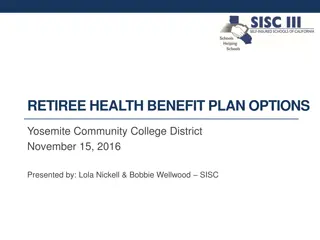VEHI School Health Care Plan Options for 2024 Open Enrollment
VEHI's webinar provides guidance for public school employees on selecting health care plans for 2024 open enrollment. No plan changes are required in 2024, with the same four plans available, each offering consistent coverage and networks. Part-time employees meeting hourly criteria receive employer contributions. Health reimbursement arrangements, HSAs, and FSAs are explained, with options outlined for out-of-pocket medical expenses.
Download Presentation

Please find below an Image/Link to download the presentation.
The content on the website is provided AS IS for your information and personal use only. It may not be sold, licensed, or shared on other websites without obtaining consent from the author. Download presentation by click this link. If you encounter any issues during the download, it is possible that the publisher has removed the file from their server.
E N D
Presentation Transcript
The information in this webinar was prepared by the Vermont Education Health (VEHI) to assist public school employees in selecting a health care plan during their school s open enrollment 2023, for coverage in calendar year 2024. 2024 VEHI Webinar with Powerpoint Presentation Initiative process in
I have VEHI coverage now. I have VEHI coverage now. Do I have to change plans in 2024? Do I have to change plans in 2024? No employee is required to CHANGE VEHI benefit plans in 2024. You may remain in the same plan you are in now. Unless required by your central office, you don t need to sign-up again to keep the same plan.
VEHIs benefit plans are NOT changing in 2024. VEHI will continue to offer: Are VEHI Plans Are VEHI Plans changing in changing in 2024? 2024? The same four plans (Platinum, Gold, Gold CDHP & Silver CDHP). Each plan covers: The same medical services and products The same medical networks, and with The same four tiers of coverage (single, two-person, parent/child[ren] and family) You can review the plans at this link.
Coverage Coverage Eligibility Eligibility Requirements Requirements & Employer & Employer Contributions Contributions for for Part Part- -Time Employees Employees If you work, on average, a minimum of 17.5 hours per week during the school year or calendar year, you are entitled to: A full employer contribution toward out-of-pocket costs (OOPs), either with an HRA or HSA, depending on the VEHI plan you select. Time A pro-rata contribution toward premium costs based on the percentage of time you work as determined by your local contract. If you have questions about health insurance contributions and part-time status, contact your local union representative or central office staff.
A Health Reimbursement Arrangement (HRA) is an employer- owned account into which an employer contributes funds for employees qualified, out-of-pocket medical and prescription services as defined by the IRS. Money not used by the employee remains with the employer. An HRA is a available with all four VEHI health plans in 2023. Remind me: What is an HRA, HSA & FSA? A Health Savings Account (HSA) is an employee-owned, account used to pay for qualified, out-of-pocket medical and prescription expenses as defined by the IRS. Money is contributed by the employer and, if desired, by the employee consistent with IRS rules. Funds not spent remain with the employee. The HSA is only available with the Silver CDHP in 2023. A Flexible Spending Account (FSA) is money set aside by an employee, pre-tax, to pay for qualified, out-of-pocket medical, prescription, vision and dental expenses as defined by the IRS. In most cases, if the money is not used within the contract period, the money is forfeited by the employee to the employer ( use it or lose it ). Some employers have a roll-over provision. Check with your central office to understand your options.
In 2024, employees are eligible for an HRA (Health Reimbursement Arrangement) with ANY of the four VEHI plans (Platinum, Gold, Gold CDHP and Silver CDHP). Are HRAs & FSAs available in 2024 with all four VEHI Plans? In 2024, employees are eligible for an FSA (Flexible Spending Account) if permitted by their local collective bargaining agreement or school district policies, AND if they do not elect an HSA with the Silver CDHP. (Only a Limited-Purpose FSA can be paired with an HSA.)
Yes. But ONLY with ONE VEHI Plan: Silver CDHP _____________________________________ Can I elect a Can I elect a Health Savings Health Savings Account Account (HSA) in 2024? in 2024? Employees CANNOT elect an HSA & CANNOT receive an employer contribution to an HSA with any other VEHI plan: Platinum (non-CDHP) HRA only Gold (non-CDHP) HRA only Gold CDHP HRA only (HSA) You will learn more about HSAs (and HRAs) later in this presentation.
You will have access to: One more thing: A debit card for Rx expenses. and If you choose an HRA HRA in 2024... Auto-pay to providers to cover medical claims.
Lets talk about money Let s talk about money premium and out premium and out- -of of- - pocket (OOP) costs pocket (OOP) costs
Lowest Overall Cost Exposure for School Employees in 2024 In 2024, licensed and non- licensed staff will have the lowest overall financial exposure -- premiums and out- of-pocket costs (OOP) combined -- if they elect coverage in the Gold CDHP.
Employer & Employee Employer & Employee Premium Premium Payments for Payments for Licensed Staff Licensed Staff
Districts will pay 80 percent of the premium for the Gold CDHP and the Silver CDHP. Premium Payment Formula for Licensed Licensed Staff Districts will pay the dollar amount equal to 80 percent of the Gold CDHP premium toward enrollment in the Platinum and Gold [non-CDHP] plans.
Employees in the Gold CDHP or Silver CDHP will pay 20 percent of the premium. More on Premium Payment Formula for Licensed Staff Employees in the Platinum or Gold [non- CDHP] plans will pay the difference between 80 percent of the cost of Gold CDHP and the cost of the same coverage in the Platinum and Gold [non-CDHP] plans. Take Note: You will pay higher premiums if you enroll in the Platinum and Gold [non-CDHP] plans. Click here to see the cost comparison.
Employer & Employee Employer & Employee Premium Premium Payments for Payments for Non Non- -Licensed Staff Licensed Staff
Employer & Employee Premium Premium Payment Payment Formula Formula for Non Non- -Licensed Licensed Staff Premium Cost Sharing Varies Across the State for non-licensed staff: On January 1, 2024, support staff who are not already paying 20 percent of their premium will pay 1 percent more than what they paid in 2023. But a non-licensed staff person will not pay more than 20 percent. Click here to see a cost comparison chart and enter your specific percentage.
Employer & Employee Employer & Employee Out Out- -of of- -Pocket Pocket (OOP) Costs for Costs for Licensed Staff Licensed Staff (OOP)
The employer will contribute to an HRA for single coverage $1,900 and $4,000 for all other tiers of coverage. Employer OOP Funding in the: Gold CDHP Gold CDHP with an an HRA HRA for Licensed Licensed Staff The employer s contribution will be a first- dollar contribution the employer s contribution must be paid first before the employee pays any out-of-pocket (OOP) balance that may be incurred. with Remember: Contributions by employer or employee to an HSA are NOT permitted with the Gold CDHP plan.
The employer will contribute to an HRA for single coverage $1,900 and $4,000 for all other tiers of coverage. Employer OOP Funding in the: Silver CDHP Silver CDHP with an with an HRA Licensed Licensed Staff The employer s contribution will be a first-dollar contribution the employer s contribution must be paid first before the employee pays any out-of- pocket (OOP) balance that may be incurred. HRA for Take Note: You have a higher OOP exposure with this plan than in the Gold CDHP. Remember: You may choose an HRA or an HSA with the Silver CDHP option only.
The employer will contribute to an HSA for single coverage $1,900 and $4,000 for all other tiers of coverage. Employer OOP Funding in the: Silver CDHP Silver CDHP with an with an HSA Licensed Licensed Staff The employer s full contribution must be deposited in the HSA by January 1. HSA for Take Note: You have a higher OOP exposure with this plan than in the Gold CDHP. Remember: This is the only plan that is allowed to have an HSA Contribution.
The employer will contribute to an HRA for single coverage $1,900 and $4,000 for all other tiers of coverage. Employer OOP Funding in the: Platinum Platinum Plan [non non- -CDHP CDHP] with an an HRA Licensed Licensed Staff Plan The employer s contribution must be first dollar the employer s contribution must be paid first before the employee pays any out-of- pocket balance that may be incurred. HRA for Take Note: You have a higher OOP exposure with this plan than in the Gold CDHP.
The employer will contribute to an HRA for single coverage $1,900 and $4,000 for all other tiers of coverage. Employer OOP Funding in the: Gold Gold Plan Plan [non CDHP CDHP] with an HRA HRA for Licensed Licensed Staff non- - an The employer s contribution must be first dollar meaning the employer s contribution must be paid first before the employee pays any OOP balance that may be incurred. Take Note: You have a higher OOP exposure with this plan than in the Gold CDHP.
Employer & Employee Employer & Employee Out Out- -of of- -Pocket Pocket (OOP) Costs for Costs for Non Non- -Licensed Staff Staff (OOP) Licensed
Employer OOP Funding in the Gold CDHP Gold CDHP with an an HRA HRA for Non Non- -Licensed Licensed Staff The employer will contribute to an HRA for single coverage $2,200 and $4,400 for all other tiers of coverage. with The employer s contribution will be a first- dollar contribution the employer s contribution must be paid first before the employee pays any out-of-pocket (OOP) balance that may be incurred. Contributions to an HSA are NOT permitted with the Gold CDHP plan.
The employer will contribute to an HRA for single coverage $2,200 and $4,400 for all other tiers of coverage. Employer OOP Funding in the Silver CDHP Silver CDHP with an with an HRA Non Non- -Licensed Licensed Staff The employer s contribution will be a first-dollar contribution the employer s contribution must be paid first before the employee pays any out-of- pocket (OOP) balance that may be incurred. HRA for You may choose an HRA or an HSA with a Silver CDHP. Remember: This is the only plan that is allowed to have an HSA Contribution. Take Note: You have a higher OOP exposure with this plan than in the Gold CDHP.
The employer will contribute to an HSA for single coverage $2,200 and $4,400 for all other tiers of coverage. Employer OOP Funding in the Silver CDHP Silver CDHP with an with an HSA Non Non- -Licensed Licensed Staff The employer s contribution must be deposited in full on January 1. HSA for You may choose an HRA or an HSA with a Silver CDHP. Remember: This is the only plan that is allowed to have an HSA Contribution. Take Note: You have a higher OOP exposure with this plan than in the Gold CDHP.
Employer OOP Funding in the Platinum Plan Platinum Plan [non non- -CDHP CDHP] with an with an HRA Non Non- -Licensed Licensed Staff The employer will contribute to an HSA for single coverage $2,200 and $4,400 for all other tiers of coverage. The employer s contribution will be a first-dollar contribution the employer s contribution must be paid first before the employee pays any out- of-pocket (OOP) balance that may be incurred. Take Note: HRA for You have a higher OOP exposure with this plan than in the Gold CDHP.
Employer OOP Funding in the Gold Gold Plan Plan [non non- -CDHP CDHP] with an with an HRA for Non Non- - Licensed Licensed Staff The employer will contribute to an HSA for single coverage $2,200 and $4,400 for all other tiers of coverage. The employer s contribution will be a first- dollar contribution the employer s contribution must be paid first before the employee pays any out-of-pocket (OOP) balance that may be incurred. HRA Take Note: You have a higher OOP exposure with this plan than in the Gold CDHP.
Maximum Financial Exposure Maximum Financial Exposure Why should you care? What is it?
MFE = Your premium cost share + your portion of out-of- pocket (OOP) costs after the district s HRA/HSA funds have been used. Maximum Maximum Financial Financial Exposure Exposure (MFE) (MFE) MFE will vary from year to year depending on your personal medical experiences and the VEHI plan you are in.
Single Coverage (FY24): Rounded to nearest dollar MFE for MFE for Licensed Licensed Educators Educators in FY24 (if they FY24 (if they max out their max out their OOP costs) OOP costs) Platinum: $4,311 in Gold: $4,326 Gold CDHP: $2,867 Silver CDHP: $4,186
Two-Person Coverage: (FY24): Rounded to Nearest Dollar MFE for MFE for Licensed Licensed Educators Educators in FY24 (if they FY24 (if they max out their max out their OOP costs) OOP costs) Platinum: $9,528 in Gold: $9,557 Gold CDHP: $5,257 Silver CDHP: $8,171
Parent/Child[ren] (FY24): Rounded to Nearest Dollar MFE for MFE for Licensed Licensed Educators Educators in FY24 (if they FY24 (if they max out their max out their OOP costs) OOP costs) Platinum: $8,447 in Gold: $8,587 Gold CDHP: $4,504 Silver CDHP: $7,516
Family (FY24): Rounded to Nearest Dollar MFE for MFE for Licensed Licensed Educators Educators in FY24 (if they FY24 (if they max out their max out their OOP costs) OOP costs) Platinum: $11,785 in Gold: $11,598 Gold CDHP: $7,279 Silver CDHP: $9,935
Where can licensed educators find more information on MFE and other insurance costs? https://vehi.org/licensed-employee/ Click on: https://vehi.org/licensed-employee/ Plan Comparison for Licensed Employees You will also find at these links a: Plan Comparison for Licensed Employees Plan Comparison for Licensed Employees Cost Comparison for Licensed Employees Cost Comparison for Licensed Employees Cost Comparison for Licensed Employees
Why VEHI cant produce the same MFE Slides for Non-Licensed Staff 1. Unlike licensed staff, non-licensed staff have different premium cost sharing across the state. 2. Different premium cost sharing = Different MFE Costs per school district. 3. Non-licensed staff can calculate their MFE by going to this link on the VEHI website: https://vehi.org/non-licensed-employee/. Follow these steps: Click on the Cost Comparison for Non-licensed Employees. Open the excel spreadsheet and fill in Cell A-2 with your district s premium co-share. Then compare the total employee exposure based on your tier of coverage. There is also a Plan Comparison for Non-Licensed Employees.
Know the Eligibility Know the Eligibility Rules for Rules for HSAs & HRAs HSAs & HRAs (It (It really really matters.) matters.)
Spouses: Spouses: Spouses for insurance purposes are those by: Marriage Domestic Partnership Civil Unions ________________________________ Domestic partners are generally NOT considered tax dependents by the IRS. If you elect a Health Savings Account (HSA), in order to pay for a Domestic Partner s medical bills from the HSA, your partner must be considered a qualifying relative under IRS rules. Check with your central office to make sure your domestic partner satisfies these rules. *Marriage *Marriage *Domestic *Domestic Partners Partners *Civil Unions *Civil Unions
Under IRS Rules: Under IRS Rules: The IRS does not allow an employee to make or receive a contribution to an HSA if the person is enrolled in: Not Every Employee Can Contribute to or Receive an Employer Contribution to a Health Savings Health Savings Account Account (HSA) Medicare (Parts A, B, C or D) or Social Security TRICARE (military health benefits). Employees not in TRICARE, but who get certain treatments at the V.A., cannot make or receive HSA contributions for 3 months. There are exceptions to this rule. A spouse s health plan, for primary or secondary coverage, if it is NOT HSA- qualified. A flexible spending account (FSA) even if the FSA is under a spouse s employer.
Your adult children are tax dependents and meet all the following criteria of tax dependency: HSAs & Adult Children HSAs & Adult Children Under federal law, your adult Under federal law, your adult children, children, ages 19 ages 19- -26 enrolled in your VEHI Plan. enrolled in your VEHI Plan. 26, can be , can be age relationship to the taxpayer financial support derived from the taxpayer full-time student status, and if they are claimed on your taxes as dependents But IRS rules say: But IRS rules say: HSA funds can be used to pay HSA funds can be used to pay medical medical bills for your children bills for your children 19 19- - to 23 to 23- -years years- -old old only if... only if...
Your adult child[ren] are: What about HSAs Funds & What about HSAs Funds & Adult Children, Ages 24 to Adult Children, Ages 24 to 26? 26? Totally Disabled or Permanently Disabled HSAs can be used to cover HSAs can be used to cover medical bills for your medical bills for your 24 26 year 26 year- -old children old children only 24- - to only if to if
Do Your HOMEWORK. Are you eligibleunder IRS rules to make or receive a contribution to an HSA? Will you be able to cover the medical & Rx bills for your adult children, ages 19-26, with your HSA? Adult children on your policy can open their own tax-free HSA account and contribute up to the annual family IRS maximum Adults 55 and older can contribute up to the annual maximums, plus an additional $1,000 per year until they are Medicare eligible Does your domestic partner meet the four IRS tests of a qualifying relative so you can be reimbursed for that partner s medical bills? Check with your central office to see if your domestic partner satisfies these tests. Before you choose an HSA HSA in 2024... Take Note: If you are NOT eligible to make or receive contributions to an HSA, you can be penalized and taxed by the IRS. Please confirm eligibility before choosing an HSA.
Keep in mind Your school district is not obligated to make contributions to an HSA if you lose your job and elect COBRA coverage. However, funds in an HSA can be used by an employee for qualified expenses during a COBRA period. Before you choose an HSA HSA in 2024... HSAs are also subject to a last month rule and testing period requirement. There can be tax and penalty consequences with these. They can be avoided, but you must know the rules first learn them, please.
One more thing about HSAs.... The HSA money remains with you, the employee. HSA funds can pay for medical expenses in 2024 or later, provided those same expenses were NOT paid for by HRA funds no double dipping allowed. If you have funds in an HSA at the end of 2023, but elect a VEHI plan with an HRA in 2024, what happens to the HSA funds? It is not forfeited if you elect an HRA in 2024. end of 2022 Beyond 2023 2023
Y You and your spouse can also be in Medicare, TRICARE, and Social Security. You can cover the medical & Rx bills for your adult children up to age 26, even if the children are NOT tax dependent(s). You can have secondary coverage under a spouse s plan. Your employer is obligated to keep making contributions to an HRA if you elect COBRA and is added to the COBRA premium. There is no last-month rule or testing requirement as there is with an HSA. Your domestic partner s medical bills can be covered without concern about tax dependency issues or qualifying relative rules. If you choose an HRA HRA in 2024...
Ask your central office or Third Party Administrator (TPA) for more details: One More Thing: Does enrollment in the Silver CDHP with an HSA come with access to a debit card for Rx expenses and auto-pay to providers? Before you choose an HSA HSA in 2024... Debit cards are included with most HSAs. An employee can choose auto-pay to providers, but an employer cannot elect that option for an employee. This is because, with an HSA, an employee determines when these funds are used.
Ask your central office or Third Party Administrator (TPA) for more details: What are the benefits of an HSA HSA... An HSA is a tax-preferred savings vehicle that provides tax-free dollars to an employee for qualified health expenses, now or in the future. Employees who use little health care can save HSA dollars over the years to build up an account that can be used at any time, tax- and penalty-free, for medical, dental, vision, or even COBRA premiums. HSA dollars can be used anytime tax-free for qualified medical expenses or can be withdrawn penalty-free after the account owner turns 65. Account owners that use HSA dollars for non- qualified medical expenses are subject to taxes and penalties.
Where can you learn more about IRS rules for an HRA & HSA? Speak to your central office personnel. Speak to customer service representatives with the Third Party Administrator (TPA) for your school district. Read the general guidance on VEHI s website.























